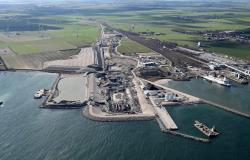It is estimated that by 2050 as many as 800 million people will live in cities where sea levels could rise by more than half a meter. For this reason, architects and engineers are thinking about how they can live on water to mitigate the problems and this is how it is about to arise Oceanix, the first floating city to the world he will find himself in South Korea (in Busan), supported by a UN program and designed by Bjarke Ingels Group. It will be built in 2025.
The idea of a floating city to face a huge challenge
Oceanix is an ambitious floating city project that was first revealed by Bjarke Ingels Group in 2019, as a concept, a concept that is now about to become reality as it has just received the green light from the UN to be built next year off the coast of South Korea. Specifically, the project was presented and approved just recently at the United Nations headquarters by UN-Habitat, the South Korean city of Busan and Oceanixa company that has designed the first sustainable floating city prototype in the world.
The challenge is enormous: two out of five people in the world live within 100 kilometers of the coast and 90 percent of the world’s largest cities are vulnerable to sea level rise. The floods Unfortunately, they are now increasingly frequent and are destroying infrastructure worth billions of dollars and forcing millions of people to leave their homes. It is a problem that Oceanix would like to solve with the creation of floating cities, which could be a way to mitigate the effects of rising sea levels caused by climate change.
How Oceanix Busan, the first sustainable floating city, is made
Designed by BIG, Oceanix will therefore be the first infrastructure in the world to develop technology to live on water without further impacting and destroying marine ecosystems. It will be a floating city composed of many hexagonal platforms.
With a’extension of 75 hectares Oceanix will be able to initially accommodate up to 12,000 people, located in the various hexagonal platforms that will still allow residents to easily walk or navigate through these “mini cities”. There will also be a public square, art installations, markets, sports clubs, schools and more. Initially there will be three neighborhoods (platforms), each with one different purpose:
- the first platform will be an accommodation area where guests will be able to enjoy accommodation with one or three bedrooms and views of the waterfront. There will also be shops and restaurants;
- the second platform will serve as a living area with residential buildings, a common courtyard and other public spaces;
- the third platform will serve as a research facility and feature a shared garden.
Everything is fine neighborhood is therefore designed for a specific use: residential, research and hospitality, from 30,000 to 40,000 square meters of multifunctional spaces. The floating platforms connect to the mainland via arched bridges from which you will have a magnificent view of the blue lagoon of Busan, with spaces for leisure, art and performances. Starting with a 3-platform community with 12,000 residents and visitors, Oceanix still has the potential to expand to over 20 platforms.
There will be no traditional forms of transport public such as traditional cars or trains: Oceanix wants there to be only pedestrians walking, cyclists and robots used to deliver packages and goods. To reach Oceanix you can use the bio-boats or go on foot from the city of Busan.
The innovative technology behind Oceanix
The platforms will be coated with Biorockthat is a floating material about three times stronger than concrete in ordinary concrete, according to Oceanix, which describes this technology as unique because it is capable of producing the only marine construction material that grows, is able to self-repair and also becomes stronger over the years. The floating platforms will be partially immersed in the water and anchored to the seabed. These anchors will be strong enough to allow the platforms to remain in place, but flexible enough to rise and fall with the water levels that change.
The city is also said to be capable of resist the worst natural disasters such as tsunamis and hurricanes. All structures will be designed below seven stories in height to create a low center of gravity, and the platforms will be built with locally sourced materials including fast-growing timber and bamboo that has great strength and can be grown in the neighborhoods themselves.
It seems that Oceanix will succeed generate 100% of the energy needs and Biorock technology itself can be powered by energy from the sun, winds, waves and even ocean currents. Specifically, energy will be collected largely from solar panelswhile sustainability will be guaranteed by an autonomous and independent way of producing the food and drinking water needed by its inhabitants.
Oceanix will integrate six interconnected systems: zero waste and circular systems, closed-loop water systems, nutrition, zero-emission energy, innovative mobility and coastal habitat regeneration. These systems will generate 100% of the necessary operational energy on site via floating and rooftop photovoltaic panels. Each neighborhood will therefore treat and replenish its own water, reduce and recycle resources and offer the possibility of innovative urban agriculture.
This innovative sustainable architectural work will have a cost over 200 million dollars which will serve to create its particular modular neighborhood structure.





